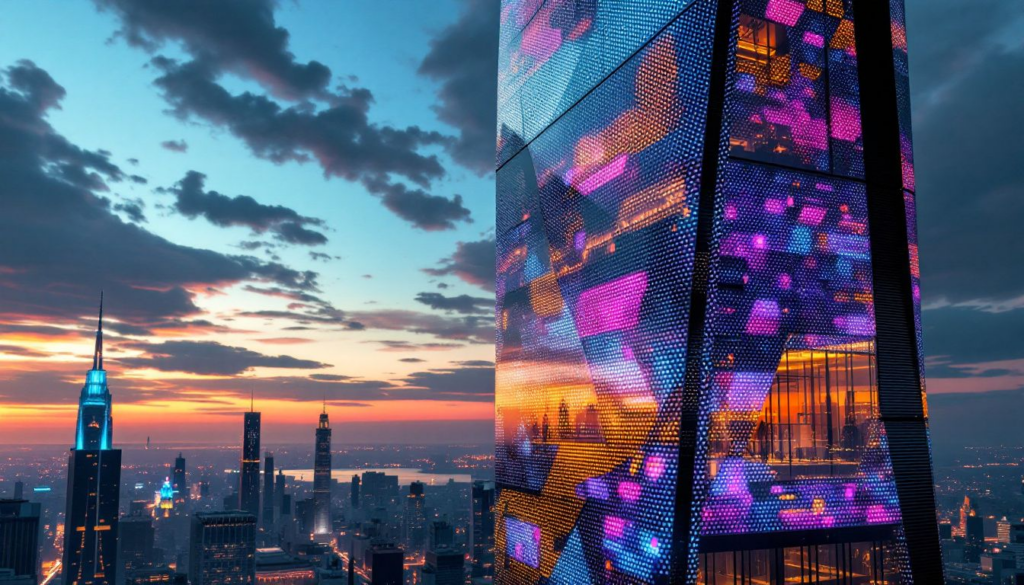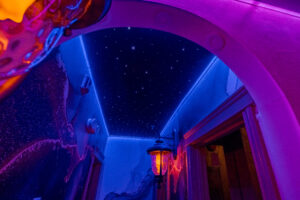Smart glass is an advanced type of glass that changes transparency or color in response to external stimuli like electricity and temperature. It’s widely used in modern homes and offices to improve energy efficiency, control privacy, and enhance aesthetics.
Understanding Smart Glass Technology

Smart glass technology is a type of glass that can change its properties, such as transparency, when stimulated by an external stimulus. This technology is gaining interest for residential and commercial use because of its dual nature: it’s both visually appealing and functional. Smart glass works by controlling light penetration through materials that are sensitive to electrical currents or similar triggers. It uses technologies like electrochromic and liquid crystal displays that can change their visibility state with an electric charge.
One of the biggest benefits of smart glass is energy saving. It can control sunlight into a room and therefore potentially lower cooling system costs. This technology allows better privacy management because you can switch between levels of transparency whenever you want.
To decide on smart glass solutions, you need to understand how they work and the different types available for you or your organization to benefit from.
How Smart Glass Works?
Smart glass technology changes the properties of glass, including shade and transparency, when stimulated by electrical currents or temperature changes. The core structure is an electrically switchable film sandwiched between two glass panels. When an electric field is applied, the liquid crystal elements in the smart glass reorient themselves systematically and control the amount of light that passes through.
In polymer-dispersed liquid crystal (PDLC) devices, tiny droplets are formed by dispersing liquid crystals in a polymer matrix that affects how light is scattered. In their natural state, without voltage applied, the crystals are randomly oriented and light is diffused and an opaque white surface is created. When voltage is applied across the PDLC electrodes, it aligns the dispersed liquid crystals and allows clear light to pass through because of reduced scattering.
Other types like thermochromic and photochromic change their properties according to environmental temperature or ambient light respectively – helping in energy saving. Beyond practicality, this material offers great possibilities for interactive smart glasses in architecture.
Types of Smart Glass
Smart glass technology has three main types that are electrically switchable: PDLC, electrochromic and thermochromic. A combination of liquid crystals between ITO and PET film layers allows PDLC (Polymer Dispersed Liquid Crystal) smart glass to go from transparent to opaque. Notably useful for its versatility, it has a layer of PDLC with laminated safety glass that gives you security features and more functionality. This tech can go from frosted opacity to clear transparency when electrified and is highly valued for better privacy management and light control.
Electrochromic smart glass changes the amount of light that passes through by changing voltage levels so you can control the shading of the windows. Advances in electrochromic technology has removed the yellow discoloration over time and presents a neutral gray color and faster switching times between states. These only require an initial pulse of electricity and is good for applications that prioritize energy saving.
Thermochromic smart glass on the other hand is sensitive to temperature changes and auto-regulates light into space based on thermal changes – doubles as interior lighting and ambient room temperature manager.
And another innovation is the suspended particle devices (SPDs) that operates under electrical control where particles in the material align themselves to allow or block light according to their arrangement when charged – an indicator of each type’s unique characteristics to be chosen depending on the environmental requirements whether you want PDLC’s confidentiality, electrochromic’s efficiency or SPD’s luminance control all contributing to modern living.
Benefits of Smart Glass
Smart film technology can save energy by changing its transparency according to light conditions so you don’t need to rely on cooling systems. Some smart windows can adjust itself according to ambient temperature which plays a big role in energy saving. For example, switchable smart films can cut solar heat gain by 40% which is an economically viable solution for indoor temperature control. The cost savings in heating and cooling will translate to big money for both residential and commercial property owners in the long run.
For energy saving, smart glass technology’s ability to switch quickly between transparent and frosted state gives you privacy while optimizing natural light in the space – making traditional window coverings like blinds or shades unnecessary and control over secrecy simplified.
Self-adhesive smart films gives you protection from UV rays without breaking the bank – adds value to glass at an affordable price. Smart glass is not just practical but also visually appealing and economically viable – a feature for modern spaces.
Smart Glass Applications

Switchable glass can adjust its light transmission automatically according to environmental conditions. This makes it suitable for various applications – residential, commercial and niche. On demand, switchable glass and film can switch between transparency and frosted state – instant privacy when you need it. Presence of Polymer Dispersed Liquid Crystal (PDLC) film technology in this type of glass allows for smooth transition from opaque to transparent upon electric current activation.
Smart windows have PDLC layers that can switch from frosted to clear upon electrical signal – controls light and privacy at will. Typically priced at $50 – $100 per square foot, smart windows are an expensive upgrade compared to regular windows.
Though the cost of acquiring smart windows is high, they justify their value across many practical scenarios – whether you’re enhancing your home or office or venturing into niche fields where adaptability is required.
Smart Glass for Homes
PriWattTM. Glass is used for residential window treatments, where homeowners can have privacy when needed. The ability to switch between transparent and opaque gives users the flexibility to hide or reveal views at will. This feature not only gives privacy but also adds style to the home – making smart film a desirable feature for modern living. Homeowners can choose from various smart glass solutions like thermochromic glass, low iron glass, prismatic film and PNLC film that are designed for residential applications.
By replacing traditional window dressings, smart windows gives you a new way to have personal space without sacrificing natural light in the home. These advanced systems can control incoming daylight which helps to preserve visual comfort, block UV and infrared light – all while keeping you warm inside through reduced heat transfer. So smart windows combines energy saving functionality with design appeal – lets in plenty of sunlight while giving you insulated privacy. A feature very useful in bathroom where it enhances sense of spaciousness and luminance.
For more practicality in the household, Self Adhesive Smart Film is a game changer with retrofit rear projection capability – a feature only available through close collaboration between customer and sales teams who will help you choose the right smart film for your needs.
The evolution of control continues as mobile device integration and voice command becomes more prominent among the latest technology for operating these smart glasses – making it easier for us to interact with our surroundings through innovations that deepens our experience – making smart transparent panels a must have in our homes.
Smart Glass for Offices
Using smart film in offices is a design solution that offers openness and private switchable glass for individual offices or meeting rooms. Commercial spaces use PriWatt Glass to manage the workplace, divide common areas and provide sleek window solutions. Smart film on windows and partitions increase privacy for employees and creates a more comfortable and productive environment.
Smart glass technology goes beyond discretion. It saves energy and enhances office design. The ability of this glass to switch between transparent and opaque gives you control over natural light. This flexibility reduces dependence on electric lighting which is good for the environment in corporate settings.
As the business landscape changes, smart glass surfaces is a forward thinking solution that fits with modern workspace design that emphasizes sustainability.
Special Applications
In the healthcare sector, smart glass is a must have for privacy on demand, especially in patient waiting areas where comfort is key. This technology has found its way into unconventional industries like healthcare and is used in hospital settings as part of glass partitions.
Using photochromic glass that adapts to UV light by becoming tinted shields from harsh sunlight while still allowing natural light in. This type of glass is used in public architecture projects. The aerospace industry also recognizes the value, using suspended particle device (SPD) glass to give airline passengers a better experience through bigger windows with more functionality.
Smart glass technology is gaining traction across all modes of transport – especially in the automotive industry – as it fits with the move towards more energy efficient vehicles. Its special applications shows not only its versatility but also the many benefits of smart glass technology, it has the potential to transform beyond the usual applications in architecture.
Installation and Maintenance of Smart Glass
Installing smart glass and film is made easy by following the pre-wired guidelines. You just need to understand the requirements for installation and maintenance whether you’re integrating smart glass in a new build or applying self adhesive smart film on existing windows to make them work and last longer.
Let’s get into the details of fitting smart glass and the key to its maintenance.
Installing Smart Glass

Smart film is a game changer that can be applied directly onto existing windows using special adhesives or its own self adhesive layer. This solution gives building owners the opportunity to upgrade their glass features whether it’s on interior partitions, sliding doors or external windows and doorways without the hassle of a full blown renovation. While smart film is easy to install like regular window films, it’s more versatile when upgrading existing glass installations.
The process of getting smart film usually involves a project manager and direct delivery to your site. This makes it easy to add this technology to your space. Professional application costs will vary depending on the complexity of the project and local labor rates.
For those who wants to do it themselves, suppliers provide detailed instructions and customer support to make DIY smart glass projects more possible for those who wants to do the upgrade themselves.
Maintenance Tips
To extend the lifespan of smart glass electrical parts must be insulated from moisture, a big consideration in areas like bathrooms. Maintenance of this technology means frequent cleaning and checking of the glass and its components to prevent issues. For existing windows or panels converted with smart film, concealed wiring is possible using slim PVC strips for a clean and sleek finish.
Regular checks and quick fixes are key to keeping smart glass high functioning. This ensures it continues to provide energy efficiency and privacy control and visual appeal. By following these care tips, property owners can enjoy the long term benefits of smart space enhancing smart glass solutions.
Cost

Technology and sustainability will drive the smart glass market with forecasts of over 15% annual growth from 2024 to 2030. The market will grow big with projections of around USD 15.79 billion by 2027 at 17.2% CAGR. Investments in renewable energy and efficient architectural solutions will fuel the global growth of smart glass technology at over 15% CAGR during the same period.
When considering smart glass as an option, it’s important to plan your finances and project scope well and understand the cost components involved. The total cost will be affected by many factors such as type of smart glass being used, complexity of installation and location. By understanding these early on, buyers can make better decisions and get more value out of this smart glass technology.
Cost Factors
Active smart glass technologies have higher costs due to the electrical connections. If customers want custom elements or advanced coatings on their smart glass, that will add to the cost. Smart glass pricing is also location dependent, urban areas have higher costs due to higher demand and transportation costs. Size, type and complexity of the system also contributes to the final cost.
To get an accurate cost for smart glass in their space, clients must share their requirements with suppliers and installers. Knowing these factors will help individuals and businesses plan their budget and be informed about smart glass in their space.
Get a Quote
Customers must get quotes from several suppliers of smart glass technology to get the details. Comparing quotes will allow them to choose the one that fits their budget and project requirements. Approving a quote ensures all specifications and requirements are covered.
Talk to a sales team to find the right smart window for your needs. Partner with suppliers and installers to get a smart glass solution for your project that’s right and cost effective.
Smart Glass Technology Trends
Future of smart glass technology will see the development of new materials that will optimise functionality and reduce cost. Smart glass combined with artificial intelligence and Internet of Things will automate intelligent buildings and transportation systems making it more accessible and adaptable and wider application across industries.
As this technology grows, we see it being mainstream in residential and commercial spaces. The popularity of smart glass is due to its multi functionality and versatility, so we see a trend towards more integrated living spaces with innovation. This will drive more innovations and new products and smart glass will be part of modern architecture and design.
Future Innovations

Future of smart glass technology will cover industries such as wearable tech and aerospace. Efforts to improve smart glass will focus on adding more functions to it such as temperature sensing and augmented reality displays. These technological advancements will expand what can be done with smart glass and open up new applications across different spaces.
As smart glass gets integrated with other technologies, its features will get more advanced and attractive. This will increase the value of investing in smart glass for both home users and businesses. The introduction of these innovations into the market will drive adoption and growth of smart glass technology.
Market Expansion
Smart glass will become a common element in residential and commercial spaces as the technology gets more mainstream and adoption increases. This rise of smart glass will see living and working spaces that are connected and innovative, driven by the need for construction that is energy efficient and sustainable.
With the growing smart glass market, we see more new products and innovations coming out to cater to different markets. This growth will create new opportunities for both businesses and consumers and smart glass will be part of modern architecture and design.
Conclusion
Smart glass is a multi faceted and cutting edge way to enhance modern spaces. This material contributes not only to energy saving and privacy but also to the aesthetic of residential, commercial and specialty spaces. Knowing how it works, types and benefits is key to making informed decisions on using it in your space.
Future of smart glass technology looks promising with new developments and growing market segments emerging. To get the most out of these innovations and get value for money on such solutions, customers should stay informed of industry trends and keep in touch with suppliers. By smart glass today you can transform your spaces for tomorrow.
FAQs
What is smart glass?
Smart glass technology allows you to change the glass transparency or add features in response to external triggers such as temperature or electrical impulses.
This is good for energy saving and privacy across many applications.
How does it work?
Smart glass works by using materials that change light transmission in response to electrical current or stimulus, using technologies such as PDLC, electrochromic and thermochromic.
This gives you more control over transparency and shading in different spaces.
What are the benefits of smart glass?
Smart glass gives you energy efficiency, privacy control and visual appeal. It reduces your dependence on aircon while providing UV protection and eliminates the need for window treatments.
Smart glass is good for commercial and residential spaces.
How to install smart glass?
Smart glass installation is like regular glass and self adhesive smart film can be retrofitted to existing windows.
Get professional help as installation cost varies with complexity and location.
What affects the cost of smart glass?
Cost of smart glass is dependent on glass type, installation complexity, location and custom features/coatings.
Consider all these to get the total cost.
Originally posted on December 19, 2024 @ 4:28 am



